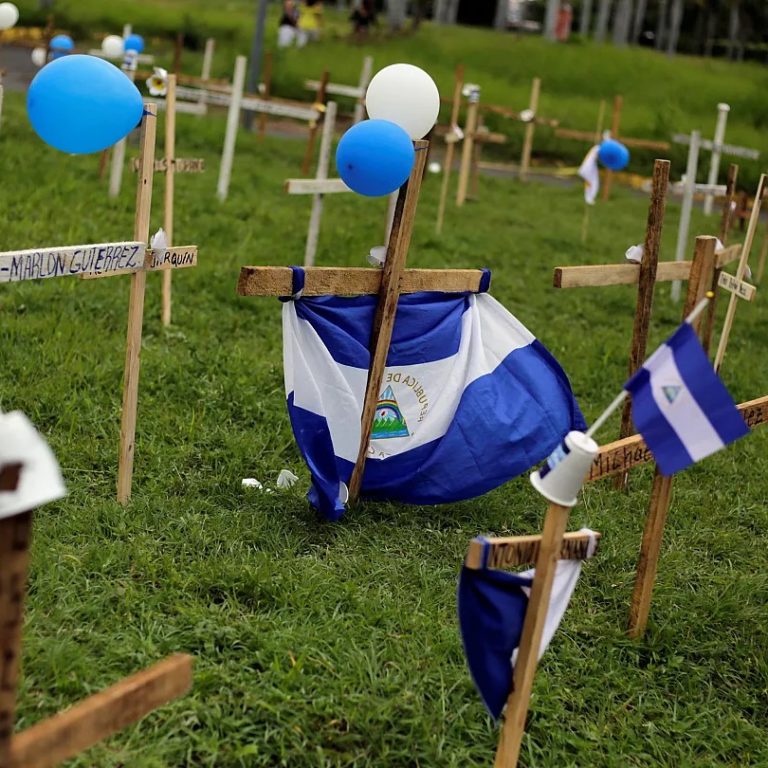Every February 14, the anniversary of having been elevated to a city in 1862 is celebrated. Its name itself is a great lesson of indigenous rebellion and of a fighting people that rises up every day with their heads held high.
Indice
ToggleHis story
n
Matagalpa has been standing since before the Spanish colonization and is one of the few cities that has been in the same place since its foundation. Both yesterday and today, the same names were heard: Matagalpa, Molaguina, Solingalpa, and Guanuca, just like their language, their warrior spirit and indomitable soul with which they won the respect of other tribes and peoples from the rest of Nicaragua.
n
The young anthropologist and local historian, Paul Cruz Olivas, considers that the records on “The Queen of Coffee” date back to 1615 when the conqueror Gabriel De Texeria arrived in the highlands of Matagalpa.

“The Catholic missionaries arrived in Sébaco where they began the process of Christianization,” explained the expert, adding that they later climbed the waters of the Rio Grande de Matagalpa until they reached the site where the future “Pearl of the Septentrión” would be founded.
He affirmed that there is a census long before the arrival of Texeria, dating from 1581. “It is the oldest census we have of the three partialities (Matagalpa, Molaguina, and Solingalpa), each one separated by about ten blocks from today,” precise.
n
According to Paul Cruz, in the official records, the Villa de San Pedro de Matagalpa is named in 1803. “It already had a considerable population, the cathedral, the first attempts to build what would be the neighborhood of Laborío, together with the indigenous community and the neighborhood of Guanuca”.
Missionaries
n
He explained that the religious missionaries were first the Mercedarians and then the Jesuits, who left an indelible mark on Villa de San Pedro.
n
In the opinion of the expert, Matagalpa ceased to be a town and became a city, thanks to its participation in the battle of San Jacinto in 1856. “Matagalpa was the provisional capital of the country in the war against Walker, but once he was defeated by the union of the Nicaraguans, on February 14, 1862, the Nicaraguan government, through congress, elevated the Villa de Matagalpa to the category of a city”, he argued.
n
“From that moment on, the political division of Matagalpa began as a department, as well as Jinotega and Chontales,” Cruz said.
n
Matagalpa is founded on a valley with mountains such as the Apante massif and El Calvario. In addition, the Río Grande crosses its urban area, with a rugged relief, plus its population of indigenous origin, to which were added the Spanish, European immigrants and other parts of the country such as Masaya, León, Managua, Granada, Caribbean Coast, among others.
Economic interest
n
Matagalpa has always been of economic interest for the Spanish Crown, for the Creoles, foreign migrations, and for the state as such and, in the opinion of Paul Cruz, that first interest was set in the exploitation of gold, copper, and iron through of mining.
“By 1860, the coffee boom began as the economic engine of Matagalpa with the first farms in San Ramón and in 1880 the golden grain became massive and then vegetables, flowers, basic grains, cocoa, among other items,” he noted.
Characters
n
The history of Matagalpa cannot be told without remembering the people who forged it from their neighborhoods or from power, but who have equally honored it with their actions, sayings, and adventures.
n
For Matagalpa historian Uriel Cardoza Sánchez, administrator of the Facebook page “Matagalpa walking yesterday and today”, dedicated to rescuing the history of the city, especially the twentieth century, to be Matagalpa is to be original, hard-working, and intellectual.
n
He remembers different characters such as Benito Morales, who was Head of State of Nicaragua in 1833, senator and prefect. Bartolomé Martínez, who was President of Nicaragua between 1923 and 1924, “the poorest and most honorable president who came out of Matagalpa,” says Cardoza.

“We must mention Don Matías Baldizón Morales, prefect of the department of Matagalpa, and economic manager for the construction of the Cathedral, Ivania Navarro Genie, Miss Nicaragua 1976, the first to arrive among the 10 finalists of Miss Universe. She was the first beauty queen to give two international crowns for the country: “Miss Teenager Intercontinental” and “Miss Tourism”. Navarro was hired by the Miss Universe organization to work on modeling tours,” she said.
n
About the colorful characters, the historian describes “Marcos Tapa” or Marcos Leiva, remembered for his ability to invent stories and facts. To Don “Pedro Cosita” or Pedro Bracamonte, a very respectful person to speak to, neat to dress, and delicate in dealing with people.
n
In Matagalpa, the story of Don Tomás Pravia stands out, known as “Colocho”, an announcer of the dead who, with his loudspeaker vehicle, informed society of the death of a Matagalpa at any time. “They say that he himself left his own death announcement recorded, with his own voice, so that his children would divulge it as he did in life,” he said.
n
“I remember don Peña and his Semites, the Morales sisters, and learning their first letters with them, don Juan Morales, whose house today is the best-known landmark in the city,” he expresses wistfully.
n
He recalled unforgettable people from the streets of the “Pearl of the Septentrión” such as “Tomasa Loca”, “Maitro Nicho”, “Leche Burra”, “Carne Amarilla”, “Chele Loco”, “Patrocinio”, “Leonidas Loco”, the unforgettable Eloy, among others.
n
In addition to his memory and experience, Uriel Cardoza is an enthusiast who compiles a series of books and historical documents about Matagalpa, so we could delve deeper into data and particularities related to the celebrated Matagalpa.
n
historical constructions
n
Taking a walk through the city of Matagalpa is to delight in its architecture, as the buildings, monuments, and ornaments represent the human talent and the taste of its people as a whole.
n
The most representative is the San Pedro Apóstol Cathedral, dedicated to the Virgen de La Merced and built between 1874 and 1895.
Anthropologist and historian Paul Cruz believe that the first stone of the cathedral was laid in 1610. “The original plans were huge,” he commented.
n
“This cathedral is the one that took the longest to build, but it was the Jesuits and the community who dedicated themselves body and soul to its successful completion,” he recounted.
The San Pedro de Matagalpa cathedral is the third-largest in Nicaragua and was declared a Historical and Cultural Heritage of the Nation by the National Assembly in 2007.
n
But there are other representative buildings of the city, such as the San José church, formerly called the Laborío or Dolores church, which served as a barracks for the Indians who took up arms in 1881.
n
The Molagüina church, formerly known as the San Felipe church, is also one of the oldest, it was built between 1751 and 1873. It has on its main altar one of the oldest crucifixes in Nicaragua, brought from Spain in 1630 and was once part of of the missions.
Similarly, there are more recent buildings such as the Episcopal Palace, headquarters of the San Luis College and the Juan Pablo II Catholic University, the Municipal Theater, the House of the Indigenous Community, the Darío, Morazán, Los Monos, Cruz de Apante parks. , among others.
n
MATAGALPA AND ITS MUSIC
n
For Paul Cruz, one of the most representative traditions of Matagalpa lies in its music, its composers, and musical performers, which was strengthened with the arrival of European immigrants, mainly German, English, Danish, Chinese, Spanish.
n
“A product of that tradition has remained forever musical pieces such as the Corrido a Matagalpa or del Centenario, El crio del bolo, Te vas, la Tayyá and many other songs that appear on an album recorded more than 20 years ago by various artists from Matagalpa with the impulse of the businessman and also northern historian Eddy Kuhl Aráuz”, he maintained.
THE LEGEND OF THE SERPENT
n
Oral tradition tells that there is a gigantic snake in Matagalpa that is tied to the Apante hill with three hairs of the Virgin Mary.
It is an indigenous myth, says Cruz: “it is related to the worship of the serpent, which the Jesuits adapted so that the indigenous people could compare the story with Catholic elements,” he recounted.
n
“It is said that a great snake lives on the Apante hill, to which the Virgin has it tied with three of her hairs. That snake has its head buried in the lagoon on the hill, its belly in the indigenous community, and its tail in the Cathedral. The movements of the snake have broken two hairs, leaving only one. Therefore, when the third breaks, the city will be flooded”, according to tradition.
THE 160TH ANNIVERSARY
n
Every February 14, Matagalpa commemorates one more anniversary of having been elevated to a city and the celebrations are diverse, picturesque, unique, and unrepeatable.

The residents organize traditional games, conferences on local history, queen elections, street parties, massive barbecues, solemn acts in which they mainly recognize the efforts of men and women by declaring them, notable citizens.
nnn
In this 2022 Matagalpa reached its 160th anniversary of being a city, with the female population being the largest, living mainly in urban areas and a good percentage in rural areas.
n
Its economy basically depends on coffee production, basic grains, cocoa, handicrafts, and small and medium private and family businesses.
n
It is the seventh-largest city in Nicaragua and one of the most commercially active, known as the Pearl of the North, for its natural characteristics and production capital, for its varied agricultural and commercial activity.
n
Matagalpa is not only the cradle of poets and musicians, it is also poetry and music in the form of a city, with landscapes that invite you to dream, customs that being unforgettable, are a pure metaphor, born of love for the land and its people.







